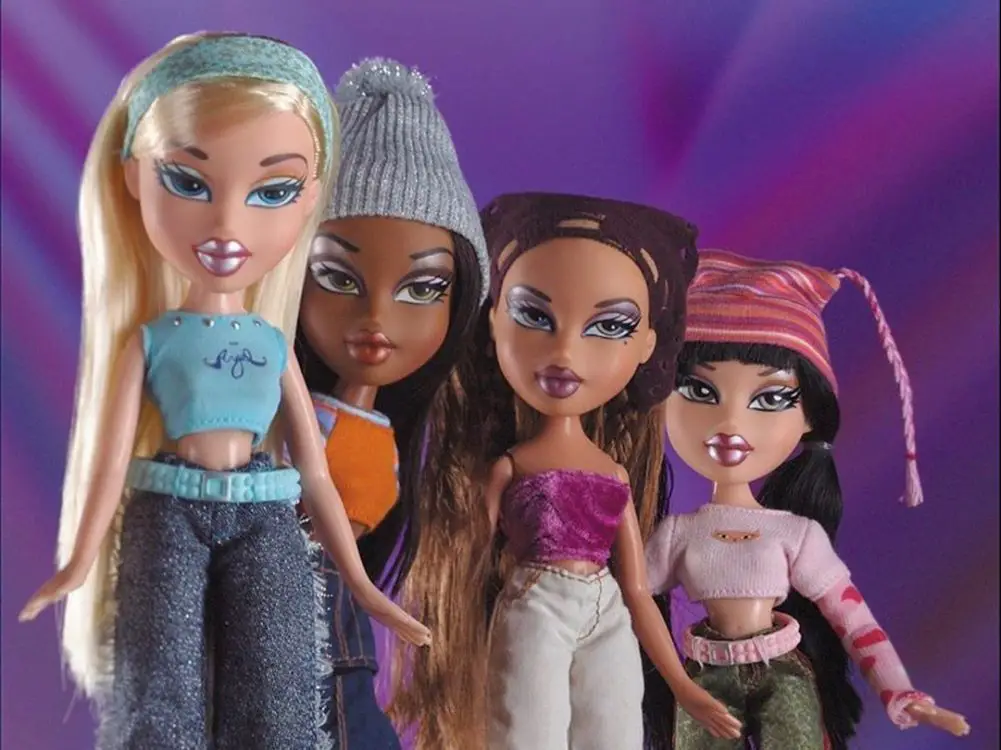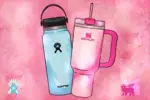Over a decade ago, Bratz were Barbie’s biggest competitor. The dolls, with their uniform plump lips, heavy eyeshadow and high-heeled shoes were controversial and deemed offensively sultry by some concerned parents. Still, the dolls made their impact on many girls’ childhoods, in particular young girls of color. Today, teens and college-aged Gen Zers play dress up by mimicking the Bratz’ street style aesthetic.
Defining the Bratz Look
Central to the 10-inch dolls’ brand image were their fashion-forward outfits. Bratz dolls were trendy (and now, trendsetting), their edgy outfits not diluted for their audience of 9-year olds. What I can remember from my collection of Bratz dolls is a heap of rubber platform boots, crop tops, fur shawls and cargo pants embellished with chains. Despite Barbie’s monopoly over the fashion doll industry, Bratz products made their own indelible stamp in the world of girls’ toys, and now, on the clothing choices of young women.
According to a Fashion Magazine writer, “Bratz have become the underappreciated style icons we never knew we needed.” So what exactly is Bratz style?
For one, the Bratz dolls dress audaciously, unafraid to turn heads with raunchy ensembles. Though the brand’s website appears to be in between doll launches, Bratz.com features a slideshow of chicly-clad dolls. Yasmin, Cloe, Jade and Sasha, the multiethnic characters that make up the brand’s quartet of girlfriends, stare out at me from under their half-lowered eyelids. They are dressed in baggy low-rise jeans with studded belts, ab-baring cropped shirts, pink choker necklaces and chunky Yeezy-inspired sneakers. They exude a fierce, self-assured attitude, something I’d emanate, too, if I had the guts to wear a reflective miniskirt.
A testament to a first-rate sense of fashion, Bratz outfits are far from intuitive. A floor-length tweed jacket might be paired with a teeny cropped tank top and rose velvet knee-high boots, for instance. Every look represents a fearless statement of personal style, rooted in self-confidence. It’s no wonder whole Internet communities are developing out of some girls’ aspirations to imitate them.
A key aesthetic choice that defines the doll line’s look is heavy makeup. In the Bratz world, “natural beauty” is certainly secondary to making a daring statement. As a girl group, the Bratz girls display an unapologetic commitment to adorning oneself boldly, confronting possible judgment head on. It’s an appropriate declaration considering the doll brand’s controversial reception after its launch in 2001. The history of MGA’s Bratz doll line is dotted with legal battles with Mattel (who owns Barbie) and criticisms from adults that the dolls were too sultry for young girls to play with.
The dolls’ plump, glossy lips and the heavy eye makeup stroked across their almond-shaped eyes — on one doll, a dark smokey-eye, on another, bright stripes of green and blue shadow — prompted the rage of some parents and feminists. In the end, however, Bratz and their perpetually beat faces have held up despite the storms. From their swollen heads to their non-existent feet (shoes attach and detach from the doll legs themselves), there’s nothing natural about a Brat, and that seems to be the point.
How the Bratz aesthetic is taking over social media
Online, the Bratz aesthetic has slowly begun to be conflated with general e-girl culture. Though you’d seldom cross someone dressed in a poorboy cap and matte black platform heels on an ordinary sidewalk, Bratz-inspired looks are prevalent on platforms like Twitter, Instagram and TikTok. Images of girls in huge shoes, pigtails and thick black eyeliner aren’t hard to find (or maybe they’re just impossible to miss). In fact, a recent debate has erupted on Twitter on the white-washing of the Bratz aesthetic, considering that one of the major appeals of the doll line was its racially diverse cast of main characters. Twitter critics have argued that the dolls’ facial features and street style are clearly modeled on women of color.
https://twitter.com/TeeMushell/status/1297143824196800513
With the #Bratzoutfit hashtag on TikTok, users will find copious media dedicated to recreating Bratz looks. Teenage and college-aged women layer clips of themselves in outfits that range from innovative twists on Y2K looks to cringey reminders of fashion’s past, all over the Bratz theme song. In one video, three users lip-sync the “Bratz” television theme dressed as their respective Bratz-lookalikes—there is Sasha, with honey-colored highlights and a half-up hairstyle; Yasmine, with blue bangs; and Jade, with star-shaped silver earrings and a sparkly choker. All three of the creators wear thick black eyeliner, have overdrawn lips for a pouty effect and have nailed the Bratz’ signature come-hither look with heavy false lashes and arched brows. The clip has over 300,000 likes. Other users up the ante with bright wigs and colored eye contacts.
In other corners of the internet, there are Instagram pages dedicated to Bratz fashion and viral YouTube challenges (the #Bratzchallenge) dedicated to replicating their exaggerated features on real faces. Bratz mania may be about more than just aesthetics, however.
The Bratz are feminist icons
In a Fashion Magazine article that calls Bratz “2019’s unlikeliest style icons,” Ellis Mathews writes that Bratz’ “approach to inclusivity and girl power was a huge part of their appeal.” The same girl-power politics seems to be boosting Bratz nostalgia today.
Bratz’ self-presentation — heavy-handed makeup, revealing streetwear and risqué shoes — is unapologetic. As feminist analysis of social attitudes toward women’s dress has established itself in the mainstream, women have vocalized their condemnation of the idea that the way they dress indicates clues about their sexuality or so-called promiscuity. While modest outfits might empower some women, revealing more skin makes others feel confident.
Attitudes toward heavy-handed makeup have also shifted, with sexist arguments about the so-called “false advertising” of glam makeup rejected for an embrace of intricate face-painting as an expression of artistry. Most importantly, women should feel empowered to wear as much or as little makeup as they want. When it comes to devaluing feminine expression that isn’t seen as “natural” or “low-maintenance,” Bratz dolls go against that line of thought that seeks to control and shame women by encouraging girls to be bold with their makeup looks.
While I think it is both a little forward and racially charged to refer to a multi-ethnic doll line for children as “sex positive,” as one Vice article describes Bratz, the dolls certainly display a kind of femininity that is brazen and non-conforming to a white patriarchal ideal. It’s probably not a coincidence that a doll line in which only one of the dolls is white has been slut-shamed by adults throughout its product career. Veronica Bayetti Flores notes in “Why Doll Make-Unders Make Me Uncomfortable” that some feminist mothers’ efforts to strip Bratz of their “trashy” style — claiming that they are more beautiful after the process — devalues the Black and Latino femmes the dolls’ fashion and makeup styles are based on.
With their hoop earrings, full lips and dramatic face-painting, the dolls have been stylized to look like Black and Latina women in low-income, segregated communities, Flores says. Dismissing traditionally feminine forms of expression as frivolous erases femme and many ethnic women from feminism. And dismissing expression through makeup and clothes as meaningless obscures how a doll line, of all things, might be empowering 18 to 24-year-old women to be themselves, via dressing for themselves and no one else.
Beyond the aesthetic tenets of Bratz culture, there seems to be a tongue-in-cheek feminism centered around the embrace of the label “brat.” Everyone knows that, like the label “diva,” it is usually women who are called brats or told they are acting like one, usually for being assertive or confrontational. Like the reclamation of “bitch,” the use of brat in femme-centered communities (such as online ones found on Twitter and TikTok), has an irony that sucks away the paternalistic and disrespectful connotations the word has when uttered as an insult. Identifying with Bratz culture — dressing like the dolls, collecting Bratz logo-embossed merchandise — likely means not caring about being considered one. Unapologetically identifying as a “brat” opens up young women’s opportunities to construct a self-image around confidence and being vocal about what they want.
The Bratz look may be an online fashion trend, but Bratz nostalgia is also pushing forward a culture of self-empowerment through feminine expression. With their provocative makeup, daring outfits and fierce attitudes, these dolls are icons of style and of a movement of self-assured feminine identity.

















